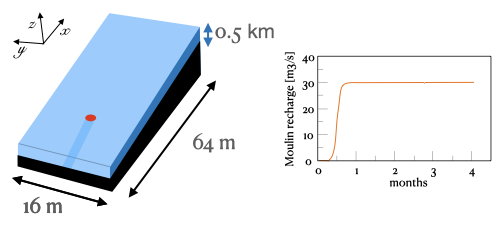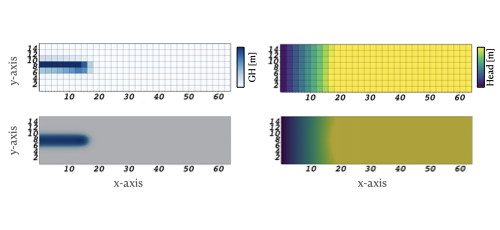Go back to the main documentation page
SUHMO’s quick start section
This section will walk you trough downloading all dependencies and compiling the sources to run a very basic 2D channelizing test case.
Dependencies
SUHMO relies on the Software for Adaptive Solutions of Partial Differential Equations CHOMBO (see home page). Make sure that you create two separate folders, one for Chombo and another one for SUHMO, as it will make following the instructions easier.
Getting Chombo v3.2
Start by downloading the feature_SUHMO branch of the forked version of Chombo 3.2:
git clone https://github.com/EnnaDelfen/Chombo_3.2.git
git checkout -b feature_SUHMO remotes/origin/feature_SUHMO
Set up the CHOMBO environment variable:
export CHOMBO_HOME=path_to_your_CHOMBO3.2_folder/lib/
Getting SUHMO v1.0
Then, get the master branch of SUHMO:
git clone https://github.com/EnnaDelfen/SUHMO.git
Set up the SUHMO environment variable:
export SUHMO_HOME=path_to_your_SUHMO1.0_folder/
Additional dependencies
On Ubuntu, use the apt-get command to get basic compiler and support libraries (MPI/HDF5):
sudo apt-get install -y --no-install-recommends \
build-essential csh \
g++-11 gfortran-11 \
libopenmpi-dev \
openmpi-bin \
libhdf5-openmpi-dev
Note that some of these might already be installed on your system, so adapt this command line accordingly.
Adapting the Make.defs.local
Go into the Chombo make folder:
cd $CHOMBO_HOME/mk
and modify the local local/Make.defs.template to provide the requested paths, according to your installation. Generate a symbolik link pointing to it as follows:
rm -rf Make.defs.local
ln -s local/Make.def.template Make.defs.local
You should be all set to compile and run your first example !
Setting up the channelizing test case
Test case description

The domain is a rectangle of 64 m in the $x$ direction by 16 m in the $y$ direction. The bed is sloped in the $x$ direction (with a +2$\%$ slope) and is topped with a slab of ice of constant thickness everywhere (500 m). A moulin delivering a total input of 30 m$^3$ s$^{-1}$ of water at steady state is located 16 m from the outlet of the domain in the $x$ direction. The geometry is shown above. The moulin influx is ramped up over a period of a little under a month. Periodicity is assumed in the $y$ direction, a homogeneous Neumann boundary condition (outlet) is prescribed at x$=$0 m while a homogeneous Dirichlet boundary condition is prescribed at x$=$64 m. Note that the moulin source term follows a Gaussian distribution.
Building the executable
Start by going into the following SUHMO test case folder and building the executable:
cd $SUHMO_HOME/exec/0_convergence_channelized
make all
Running the first example
Go into the 1lev test case and launch your first SUHMO simulation:
cd 1lev
../Suhmo2d.**.ex input.hydro
If everything goes according to plan you should not have to wait more than a minute for the simulation to complete. The following files should have been generated:
- A
pout.0output file filled with run information - A check file
chk003000.2d.hdf5to restart your simulation if needed - 2 plot files
plot00XXXX.2d.hdf5corresponding to the initial and final states of your simulation
Analysing the results
There are several tools that enable you to visualize simulations results. ParaView is an option, as well as VisIt.
The fields of gap height and head resulting from this (coarse) simulation are shown in the top row of the following image. Note that the discretization is 32x8, leading to a $\Delta_x$ of 2 m. This test case can be used to run a convergence study, and results from a much finer mesh are also shown, in the bottom row. In that case, the discretization is 512x128 so that $\Delta_x$ is 0.125 m (input files for that run are provided in the 5lev test case folder).

The pout.0 file can also be checked for useful information. The number of Picard iterations, FASMG iterations (for $h$) and MG iterations (for $b$) are reported for each time step. The first 50 timesteps exhibit from 2 to 3 Picard interations and over 30 FASMG iterations while the initial state gets settled. Then the moulin input ramps up and as many as 7 Picard iterations are required for another 200-300 iterations, while the channel develops. Steady state is reached soon after.
Go a bit further
Congrats on running your first SUHMO test case !
You will note many subfolders in the 0_convergence_channelized exec folder. All subfolders labelled Xlev, where X is a number, are single level simulations. Subfolders labelled Xlev_base are 2 level simulations, where the base level refinement is as for the Xlev. Subfolders labelled Xlev_base2levs are 3 level simulations, where the base level refinement is as for the Xlev.